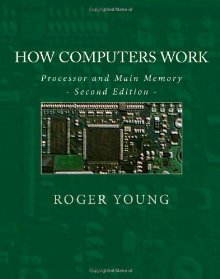
- Title How Computers Work: Processor and Main Memory
- Author(s) Roger Young
- Publisher: 1st Books Library (August 1, 2002); CreateSpace, 2 edition (April 17, 2009)
- Paperback: 152 pages
- eBook Online, HTML, PDF
- Language: English
- ISBN-10: 1442113987
- ISBN-13: 978-1442113985
How Computers Work
Processor and Main Memory
Roger Young
All rights reserved.
If you already know something about electronics, don't be put off by the fact that the book starts out very simple and uses relays instead of transistors. You will get through the first chapter quickly. See web page 24, below, for just how complex it gets.
If you have a very fast connection (DSL or cable modem), then you can click the following link to see an easier to read (PDF) version of the book. It is 783 kilobytes, so it will take a while.
PDF version
With a regular (56K) modem, it will take about 3 or 4 minutes to be displayed.
The pdf does not include the addendum on the 'registers on bus' computer architecture.
If you print this book ('How Computers Work: Processor and Main Memory') out, it will be easier to follow when it gets to large, relatively-complex diagrams.
Please email questions or comments to me (Roger Young) at:
young@fastchip.net
This book has been used as a supplementary text in 300 level computer science courses.Last updated: October 25, 2012
About The Author
This page can be reached indirectly by going to the easy-to-remember URL howcomputers.com in case you want to tell anyone about it.
Introduction
Did you ever wonder what a bit, a pixel, a latch, a word (of memory), a data bus, an address bus, a memory, a register, a processor, a timing diagram, a clock (of a processor), an instruction, or machine code is? Though most explanations of how computers work are a lot of analogies or require a background in electrical engineering, this book will tell you precisely what each of them is and how each of them works without requiring any previous knowledge of computers or electronics. However, this book starts out very easy and gets harder as it goes along. You must read the book starting at the first page and not skip around because later topics depend on understanding earlier topics. How far you can get may depend on your background. A junior high school science background should be enough. There is no mathematics required other than simple addition and multiplication. This is a short book, but it must be studied carefully. This means that you will have to read some parts more than once to understand them. Get as far as you can. You will be much more knowledgeable about how computers work when you are done than when you started, even if you are not able to get through the whole text. This is a technical book though it is aimed at a non-technical audience. Though this book takes considerable effort to understand, it is very easy for what it explains. After you have studied this book, if you go back and read it, it will seem simple. Good Luck!
No comments:
Post a Comment